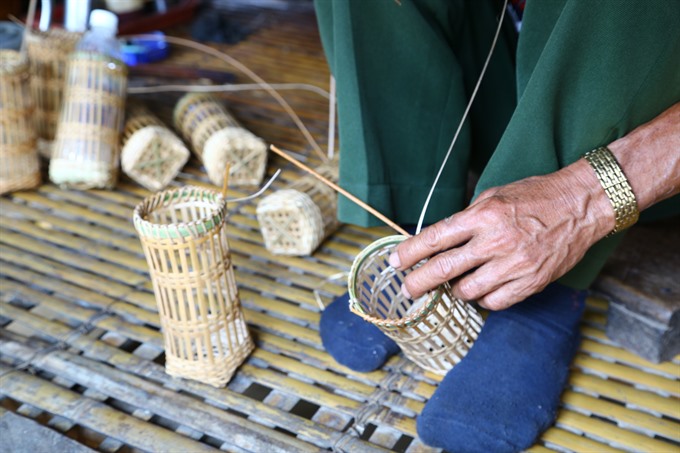Viet Nam News
A few years ago, Co Tu villagers in Nam Giang District could not imagine that their community’s daily activities could bring them a significant income source. By sharing their rice preparation, rattan knitting, cooking, singing and dancing with tourists, they make money while preserving traditions. Hong Minh reports.
On a two-hour bus trip from Da Nang City to the central province of Quang Nam’s Nam Giang District, I tried to learn a few common words of the ethnic Co Tu language: K’ro ka? (How are you?), Iem (tasty), and Liem (beautiful).
Passing through green fields and forests along National Highway 14B to reach Parong Village in Ta Bhing Commune, we were told that the Co Tu people appreciate it when visitors to the village can speak the local language.
The village is getting more visitors these days: It was the first stop of our trip to experience community-based tourism here, where a new project aims to improve local quality of life while giving travellers the chance to experience daily activities such as pounding rice, chopping firewood, and knitting rattan household utensils.
As the bus stopped at the village gate, a group of villagers in traditional costumes rushed to say hello and clapped their hands cheerfully to welcome us. The salutation K’ro ka was exchanged as if we were relatives being welcomed back home.
The Co Tu in Nam Giang continue to struggle to make a comfortable living and provide for their families. Nguyen Van Phi, deputy head of the district’s culture section, said around 68 per cent of the population was still poor in 2016.
The community-based tourism project aims to change that.
The project dates back to 2012. That year, the Japanese non-governmental organisation Foundation for International Development/Relief (FIDR) tried to help restore Co Tu traditional brocade weaving under a project funded by the Japan International Co-operation Agency (JICA). They found out that only eight women in Ta Bhing Commune knew how to make brocades.
With assistance from FIDR, Zo Ra Village has set up a traditional brocade weaving co-operative, with 40 members.
 |
| Portable: Knitting water-bottle keepers can help Parong village chief Zuong Noonh earn an income of VND2 million a month. |
To help the products of Co Tu weavers reach customers, in 2015 a community-based tourism co-operative was set up in Ta Bhing Commune with the participation of volunteer villagers.
A community-based tourism project has been implemented in all seven villages of the commune, with technical training from FIDR and sponsorship from JICA,
Briu Thuong, director of the co-operative, said that the organisation distributes tasks and income across the villages, ensuring benefits for all.
“The community-based tourism in Ta Bhing commune is very unique,” Thuong said.
According to Thuong, community-based tourism of the Co Tu followed the basis of takaramono sagashi, or hunting for treasures, one of the methods used in participatory community development in Japan. Accordingly, the co-operative will research, explore and commercialise tourism products of the local area, such as restoring traditional dishes, weaving techniques and folk dance.
“Joining in tourism has gradually brought significant benefits for the Co Tu,” Thuong said. “Young people want to learn more about the national culture, old people want to teach traditional culture to the younger generation. Co Tu elderly people are treasures as they know a lot about traditional customs and habits that need to be researched and promoted.”
 |
| Villagers warmly welcome guests from the village entrance. |
Seven villages, seven traditions
What does all of this mean for visitors, for locals and for interactions between the two groups? I wanted to find out, so I joined a trip to visit the villages.
At our first stop in Parong Village, women showed us how to pound rice and chop firewood, which seemed to be simple but turned out to be very difficult, and an unusual tourism experience.
Village chief Zuong Noonh, though in his 70s, can weave water-bottle keepers very fast. He said each product can be sold to tourists seeking an easier way to carry their water bottles. He sells them for VND50,000 each, or some VND2 million in total a month, which has helped him to increase the family income beyond what they can make from field work.
At noon, we visited Pa La Village which is in charge of culinary culture. Local dishes were prepared and served at the village’s communal Guol house, the long house on stilts in the middle of the Co Tu village that serves as a meeting place and site of cultural activities for the rest of the village.
Inside the typical Guol house of the Co Tu people, characterised by wooden columns and walls decorated with carved figures such as birds, mammals, fishes and leaves, we enjoyed the well-cooked and tasty dishes of the forest.
These included com lam (sticky rice grilled inside a bamboo tube), grilled pork with forest herbs, chicken cooked with eggplant, zo ra (local salty dishes made from meat, frogs, birds, fish, mixed with bamboo shoots and spices and then put on bamboo tube to grill) and banh sung trau (buffalo horn-shaped steamed rice cake). The head of the culinary group and other guides sat with us and introduced us to each dish.